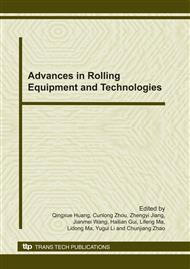p.49
p.57
p.61
p.68
p.73
p.80
p.87
p.93
p.100
A Robust Model for Work Roll Bending Control Reaching Threshold in Flatness Control of Cold Rolling Mill
Abstract:
The work roll bending is one of the most effective flatness actuators in flatness control of cold rolled strips, as a result of its characteristics such as high speed response, powerful effects on the elimination of flatness defects such as edge-waves, central waves and so on. The existing research on flatness control mainly focuses on the calculation of optimal adjustment of individual flatness actuator. However, the final output of a flatness actuator is required to be limited firstly for some special cases. If the incoming strip is coming with big symmetrical flatness defects, it happens that the position limit of work roll bending is prone to be reached or exceeded during the execution of the displacement, resulting in the residual symmetrical flatness defects without further elimination, as well as a limited flatness control process. In order to avoid this situation, substitution control by intermediate roll bending in case of work roll bending control over-limitation have been developed, which is based on actuator efficiencies and in accordance with the practical conditions. Applications show that the substitution control of intermediate roll bending for work roll bending over-limitation can play an important role in the residually symmetrical flatness control.
Info:
Periodical:
Pages:
73-79
Citation:
Online since:
October 2010
Authors:
Keywords:
Price:
Сopyright:
© 2011 Trans Tech Publications Ltd. All Rights Reserved
Share:
Citation:


